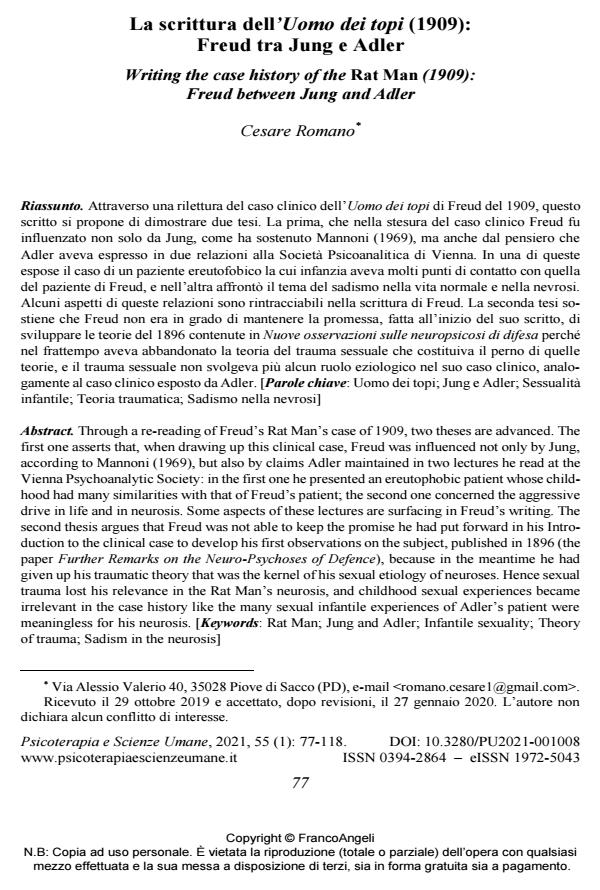La scrittura dell’Uomo dei topi (1909): Freud tra Jung e Adler
Titolo Rivista PSICOTERAPIA E SCIENZE UMANE
Autori/Curatori Cesare Romano
Anno di pubblicazione 2021 Fascicolo 2021/1
Lingua Italiano Numero pagine 42 P. 77-118 Dimensione file 521 KB
DOI 10.3280/PU2021-001008
Il DOI è il codice a barre della proprietà intellettuale: per saperne di più
clicca qui
Qui sotto puoi vedere in anteprima la prima pagina di questo articolo.
Se questo articolo ti interessa, lo puoi acquistare (e scaricare in formato pdf) seguendo le facili indicazioni per acquistare il download credit. Acquista Download Credits per scaricare questo Articolo in formato PDF

FrancoAngeli è membro della Publishers International Linking Association, Inc (PILA)associazione indipendente e non profit per facilitare (attraverso i servizi tecnologici implementati da CrossRef.org) l’accesso degli studiosi ai contenuti digitali nelle pubblicazioni professionali e scientifiche
. Attraverso una rilettura del caso clinico dell’Uomo dei topi di Freud del 1909, questo scritto si propone di dimostrare due tesi. La prima, che nella stesura del caso clinico Freud fu influenzato non solo da Jung, come ha sostenuto Mannoni (1969), ma anche dal pensiero che Adler aveva espresso in due relazioni alla Società Psicoanalitica di Vienna. In una di queste espose il caso di un paziente ereutofobico la cui infanzia aveva molti punti di contatto con quella del paziente di Freud, e nell’altra affrontò il tema del sadismo nella vita normale e nella nevrosi. Alcuni aspetti di queste relazioni sono rintracciabili nella scrittura di Freud. La seconda tesi sostiene che Freud non era in grado di mantenere la promessa, fatta all’inizio del suo scritto, di sviluppare le teorie del 1896 contenute in Nuove osservazioni sulle neuropsicosi di difesa perché nel frattempo aveva abbandonato la teoria del trauma sessuale che costituiva il perno di quelle teorie, e il trauma sessuale non svolgeva più alcun ruolo eziologico nel suo caso clinico, analogamente al caso clinico esposto da Adler.
Parole chiave:Uomo dei topi; Jung e Adler; Sessualità infantile; Teoria traumatica; Sadismo nella nevrosi
Cesare Romano, La scrittura dell’Uomo dei topi (1909): Freud tra Jung e Adler in "PSICOTERAPIA E SCIENZE UMANE" 1/2021, pp 77-118, DOI: 10.3280/PU2021-001008